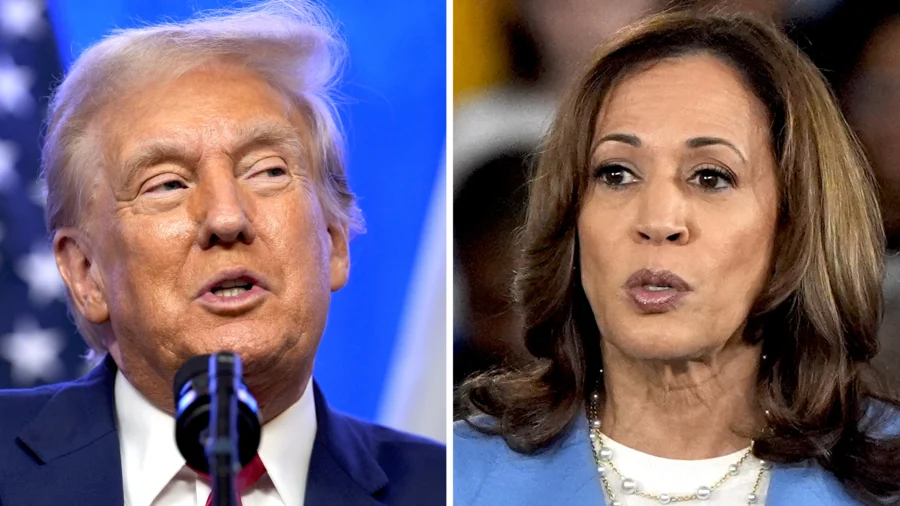Leading up to the 2024 presidential election, the tax and budget policies proposed by former President Donald Trump and Vice President Kamala Harris vary greatly, but both carry significant implications for the federal deficit and the U.S. economy.
Among 20 promises outlined in the 2024 GOP Platform: Make America Great Again! a potential Trump administration vowed “large tax cuts for workers and no tax on tips.”
As part of that, the document states that a new Trump administration would offer tax incentives for first-time home buyers and provide tax credits to support unpaid family caregivers caring for the elderly.
The 16-page-long document tied tax cuts with tariffs.
“As Tariffs on Foreign Producers go up, Taxes on American Workers, Families, and Businesses can come down,” it said.
The plan is also to make permanent the provisions of Trump’s 2017 Tax Cuts and Jobs Act (TCJA) that’s set to expire in 2025. The Act included doubling the standard deduction and expanding the Child Tax Credit, which “spurred economic growth for all Americans,” the document says.
Overall, Trump’s proposals center on more tax cuts and higher tariffs on imports, which are aimed at boosting the economy through job creation and local manufacturing, according to an analysis by the Penn Wharton Budget Model, an economic research branch of the University of Pennsylvania’s Wharton School.
Key elements of Trump’s plan include reducing the corporate income tax rate to 15 percent, eliminating income tax on tips and Social Security benefits, and imposing a 10 percent across-the-board tariff on all imports, according to the budget model.
The TCJA had cut corporate taxes from 35 percent to the current 21 percent, and gave businesses more room to deduct from their taxable income for business investment and research and development costs.
Wharton’s budget model predicts that Trump’s proposed policies would increase primary deficits by $5.8 trillion due to an equal amount of loss of tax revenue over the next decade, or down to $4.1 trillion when measuring their potential effects on the economy. The same analysis predicts his policies would initially boost the GDP, but eventually lead to a decline of 0.4 percent in 2034 and 2.1 percent by 2054.
According to an analysis by the Peter G. Peterson Foundation—a billionaire-backed nonprofit that analyzes America’s fiscal challenges, Congressional Budget Office predictions show current non-interest spending in the federal budget will continue to exceed revenues for the federal government, which would increase primary deficits by $9.2 trillion over the next decade.
The budget model’s projections would be in addition to current policies.
Harris’s Tax Plan
Following a different approach, Harris’s tax plan would impose higher taxes on corporations and top-income earners while putting more money into the pockets of low- and middle-class families.
According to her campaign, Harris has promised not to impose new taxes on anyone earning below $400,000 a year, and will cut taxes for low- and middle-class families with kids. She has also offered first-time homebuying incentives and would make permanent some health insurance premium subsidies.
Expanding on the 2021 American Rescue Plan Act (ARPA), she is proposing to expand the Child Tax Credit, which provides a tax credit of up to $3,600 per child for low- and middle-class families. Adding to that, a new credit for families with a baby under 12 months could qualify for a bigger credit—up to $6,000—for when “expenses are highest,” according to an August campaign announcement.
She would also make permanent a premium tax credit under ARPA that allows individuals earning at or above the federal poverty level to receive health insurance subsidies. The credit was first enacted by the Obama administration under the Affordable Care Act of 2010.
Harris’s plan would raise the corporate income tax rate to 28 percent, provide an average of $25,000 in down payment assistance for first-time homebuyers, and raise the top income tax rate for those in the top 1 percent of earners from 37 percent to 39.6 percent, according to analyses by the Wharton School and the Tax Foundation—which calls itself the nation’s leading nonpartisan nonprofit on tax policy.
The same budget model predicts that Harris’s policies would lead to a decrease in GDP of 1.3 percent in 2034 and by 4 percent in 2054, which is less than the predictions under Trump’s plan.
The model estimates that Harris’s policies would increase primary deficits by $1.2 trillion more than current policies over the next decade or by $2 trillion when accounting for economic impacts, which includes a “reduction in economic activity,” according to the budget model.
Harris’s policies would increase spending by $2.3 trillion, but also increase tax revenue by $1.1 trillion, for a difference of the $1.2 trillion in primary deficits, according to the model, which increases to $2.0 trillion after projected economic harms.
The two policies highlight different approaches, with Trump’s plan focusing on economic growth and tax cuts and Harris’s on increasing tax revenue and reducing income inequality.
According to the Tax Foundation, both candidates’ plans could have mixed effects. They said that while all income groups under Trump’s plan could see increases in their after-tax income, in the short term, the federal deficit could significantly increase in the long term, which could have negative impacts.
Harris’s plan could potentially reduce the deficit but dampen economic growth and job creation, the foundation said. According to the budget model, Harris’s plan could lead to decreased after-tax income for higher-income households but potentially benefit lower-income households with expanded tax credits and social programs.

